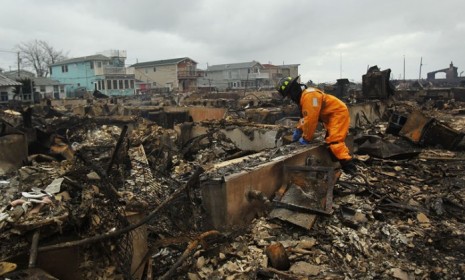Could Hurricane Sandy actually help the economy?
The superstorm ravaged the Eastern Seaboard and threw sand in the economy's gears. But the stimulative effect of reconstruction could result in a net gain

At first glance, the economic havoc wrought by Superstorm Sandy seems exceedingly grim. The storm battered the most densely populated area of the U.S., which accounts for a quarter of the nation's GDP. Initial estimates suggest that Sandy caused about $20 billion in damages, and that figure could even rise to $50 billion, topping Hurricane Katrina in 2005. The storm tore up infrastructure, shut down transportation, caused widespread power outages, and snarled telecommunications networks. Each day that the economy remains in limbo costs an estimated $10 billion in output, and economists already predict that Sandy will have noticeable impact on GDP for the fourth quarter, say Chris Burritt and Brian K. Sullivan at Bloomberg:
Sandy ultimately may subtract 0.1 to 0.2 percentage points from U.S. gross domestic product in the fourth quarter as spending drops on services such as restaurant meals, according to Mark Vitner, a senior economist at Wells Fargo Securities LLC in Charlotte, North Carolina. The economy, with annualized GDP of $13.6 trillion, expanded at a 2 percent pace in the third quarter.
“There’s a loss of activity that’s going to be hard to make up,” Vitner said yesterday. “If you’re a restaurant and you’re closed today, people are not going to eat two lunches tomorrow.”
The Week
Escape your echo chamber. Get the facts behind the news, plus analysis from multiple perspectives.

Sign up for The Week's Free Newsletters
From our morning news briefing to a weekly Good News Newsletter, get the best of The Week delivered directly to your inbox.
From our morning news briefing to a weekly Good News Newsletter, get the best of The Week delivered directly to your inbox.
However, there is a silver lining to the economic disaster, says Neil Irwin at The Washington Post:
There will be an almost perverse boost in overall economic activity, as efforts to clear damage and rebuild houses and businesses add to the gross domestic product...
The storm depleted some of the nation’s “capital stock” — houses, stores, and bridges and other infrastructure were destroyed. The country is, in effect, poorer by whatever amount the damage comes to. But the urgent need to rebuild will create jobs and spur economic activity...
Where will the money come from? Some of it will be funded by government, at the local, state, and federal levels. But a lot of the new money in the economy will come from the insurance industry, says John W. Schoen at NBC News:
A free daily email with the biggest news stories of the day – and the best features from TheWeek.com
Only a portion of Sandy-related losses will be covered. Some businesses and households may never recover their losses. Others will be long-term winners, using claim payouts to rebuild and make improvements.
But the process will inject tens of billions of dollars, money that otherwise would not have been spent, into the regional economy. The increased spending will produce ripple effects for companies supplying the products and services needed to repair the damage, from construction firms to car dealers.
The money to pay for all this will be drawn from the roughly $500 billion in capital accumulated by the global insurance industry through premiums collected in years past.
As a result, there is even a chance that the disaster could end up being a net positive for the overall economy. What's more, the damage could encourage companies to make their businesses more efficient. Think of it this way, says Irwin. "Utilities may have resisted investing in underground power lines because of the expense. But after this hurricane, they may be more inclined to bury those lines, significantly reducing power outages during future storms."
-
 Trekking with gorillas in the warm heart of Africa
Trekking with gorillas in the warm heart of AfricaThe Week Recommends Great apes and an unforgettable encounter with elephants in the forests and swamps of the Congo
-
 New START: the final US-Russia nuclear treaty about to expire
New START: the final US-Russia nuclear treaty about to expireThe Explainer The last agreement between Washington and Moscow expires within weeks
-
 What do the people of Greenland want for their future?
What do the people of Greenland want for their future?As Europe prevaricates over US threats for annexation there is a unifying feeling of self-determination among Greenlanders